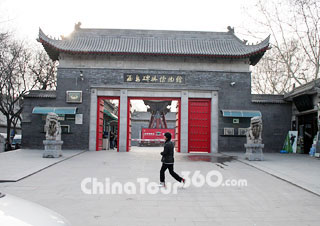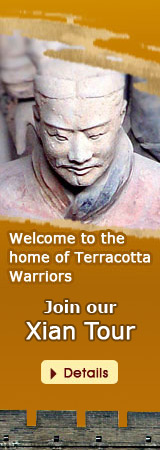 Xian Forest of Stone Steles
Xian Forest of Stone Steles
Originally built in 1087, the Forest of Stone Steles is a treasure house with the largest collection of the stone tablets in China. The exhibits of inscribed stones and epigraphs amount to more than 3,000 pieces which range from the Han Dynasty (206 BC - 220 AD) to the Qing Dynasty (1644 - 1911). As the huge collection looks like a thick forest, it is named as Forest of Stone Steles.
Covering an area of 31,900 square meters (7.9 acres), the museum is now a labyrinth of six corridors, seven rooms and eight pavilions. Mainly the works of calligraphy, painting and historical records are on display in the exhibition halls. The museum is well-known on the grounds that it not only records the great achievement of the native culture, but also reflects the fact of the cultural exchanges with other countries.
The museum is typically Chinese monastic architectural complex. It was built on the site where the Confucius Temple located.
In front of the first exhibition hall stands the stele, which was specifically designed for the display of the Shitai Xiaojing Steles, the biggest in the museum. Inscribed in 745, it was written by Xuanzong Li Longji in Tang Dynasty (618 - 907). 'Classics on Filial Piety' focusing on the filial piety was compiled by the Confucius's student. The preface was edited by the Emperor Xuan Zong, who meant to rule over the country with filial duty, the small-sized characters were the caption he made. The stele was inscribed with vivid patterns like weed vine and lion flower. It is called Shitai Xiaojing (filial piety) Steles because it is made up of 4 stones with a stone table as the foundation. The 'Kaicheng Stone Classics' is mainly displayed in the first exhibition hall. 114 steles are taken up to inscribe the 12 scriptures with the Book of Changes, the Book of History, the Book of Songs, the Rites of Zhou, the Analects of Confucius and some other books included, which are the must for the intellectuals of the feudal society. The classic works were inscribed on the steles, for one thing the printing was underdeveloped at that time, and for another some written errors could be avoided. Kaicheng Shijing Classics is the only lapidarian scripture in complete preservation at present. In the second Exhibition Hall similar steles are stored constituting the Holy Buddhist Scriptures.
Forest of Stone Steles is also a showcase of the finest examples of Chinese calligraphy made by the famous calligraphers from Han to Tang Dynasty. It is where people used to come and get stone rubbings of the tablets, then go home and try to emulate the style. Unlike English or Roman languages, Chinese characters are pictographic instead of the combinations of different letters. There are artistic elements in it. After hundreds of years, many of these stones show variations in style that make them works of art in written language, as well as historical documents.
A fine stele tablet is the integration of painting, carving, calligraphy and culture. The significance of the forest steles lies in they are precious materials for the study of fine painting, calligraphy and carving skills in ancient China and for studying the history of religion in China and ancient Sino-foreign exchanges.
![]() Entrance Fee:
Entrance Fee:
CNY 75 (Mar. 1 to Nov. 30); CNY 50 (Dec. 1 to the end of Feb.)
Free for Chinese seniors aged 70 and above with a valid Chinese ID certificate.
![]() Opening Hours:
Opening Hours:
08:00 - 18:45 (Mar. 1 to Nov. 30, but visitors are advised to enter before 18:00);
08:00 - 18:00 (Dec. 1 to the end of Feb., but visitors are advised to enter before 17:15)
![]() Bus Routes: Take Bus No. 14, 23, 40, 118, 208, 213, 214, 221, 222, 232, 302, 309, 402, 512, 710, 704, 800, Tourism Bus No. 6, Tourism Bus No. 4 (Through) or Wulong Special Line and get off at Wenchang Gate, and then walk to the museum.
Bus Routes: Take Bus No. 14, 23, 40, 118, 208, 213, 214, 221, 222, 232, 302, 309, 402, 512, 710, 704, 800, Tourism Bus No. 6, Tourism Bus No. 4 (Through) or Wulong Special Line and get off at Wenchang Gate, and then walk to the museum.








